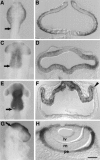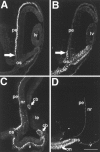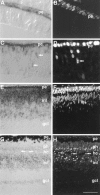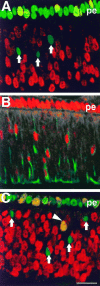Implication of OTX2 in pigment epithelium determination and neural retina differentiation
- PMID: 9151741
- PMCID: PMC6573571
- DOI: 10.1523/JNEUROSCI.17-11-04243.1997
Implication of OTX2 in pigment epithelium determination and neural retina differentiation
Abstract
The expression pattern of Otx2, a homeobox-containing gene, was analyzed from the beginning of eye morphogenesis until neural retina differentiation in chick embryos. Early on, Otx2 expression was diffuse throughout the optic vesicles but became restricted to their dorsal part when the vesicles contacted the surface ectoderm. As the optic cup forms, Otx2 was expressed only in the outer layer, which gives rise to the pigment epithelium. This early Otx2 expression pattern was complementary to that of PAX2, which localizes to the ventral half of the developing eye and optic stalk. Otx2 expression was always observed in the pigment epithelium at all stages analyzed but was extended to scattered cells located in the central portion of the neural retina around stage 22. The number of cells expressing Otx2 transcripts increased with time, following a central to peripheral gradient. Bromodeoxyuridine labeling in combination with immunohistochemistry with anti-OTX2 antiserum and different cell-specific markers were used to determine that OTX2-positive cells are postmitotic neuroblasts undergoing differentiation into several, if not all, of the distinct cell types present in the chick retina. These data indicate that Otx2 might have a double role in eye development. First, it might be necessary for the early specification and subsequent functioning of the pigment epithelium. Later, OTX2 expression might be involved in retina neurogenesis, defining a differentiation feature common to the distinct retinal cell classes.
Figures






References
-
- Acampora D, Mazan S, Lallemand Y, Avantaggiato V, Maury M, Simeone A, Brûlet P. Forebrain and midbrain regions are deleted in Otx2−/− mutants due to a defective anterior neuroectoderm specification during gastrulation. Development (Camb) 1995;121:3279–3290. - PubMed
-
- Altshuler D, Turner DL, Cepko CL. Specification of cell types in the vertebrate retina. In: Lam DMK, Shatz CJ, editors. Development of the visual system: proceeding of the retina research foundation symposia. MIT; Cambridge, MA: 1991. pp. 37–58.
-
- Ang SL, Jin O, Rhinn M, Daigle N, Stevenson L, Rossant J. A targeted mouse Otx2 mutation leads to severe defects in gastrulation and formation of axial mesoderm and to deletion of rostral brain. Development (Camb) 1996;122:243–252. - PubMed
-
- Austin CP, Feldman DE, Ida JA, Cepko C. Vertebrate RGCs are selected from competent progenitors by the action of Notch. Development (Camb) 1995;121:3637–3650. - PubMed
-
- Bally-Cuif L, Gulisano M, Broccoli V, Boncinelli E. c-otx-2 is expressed in two different phases of gastrulation and is sensitive to retinoic acid treatment in chick embryo. Mech Dev. 1995;49:49–63. - PubMed
Publication types
MeSH terms
Substances
Grants and funding
LinkOut - more resources
Full Text Sources
Other Literature Sources
Research Materials
